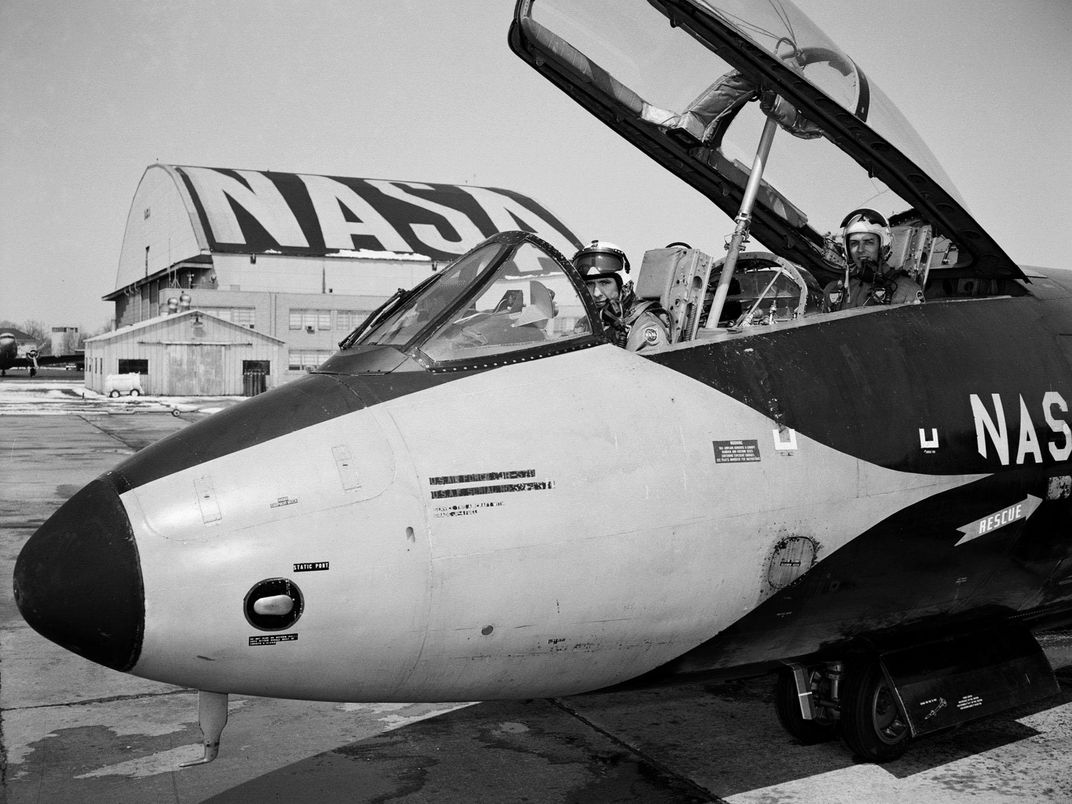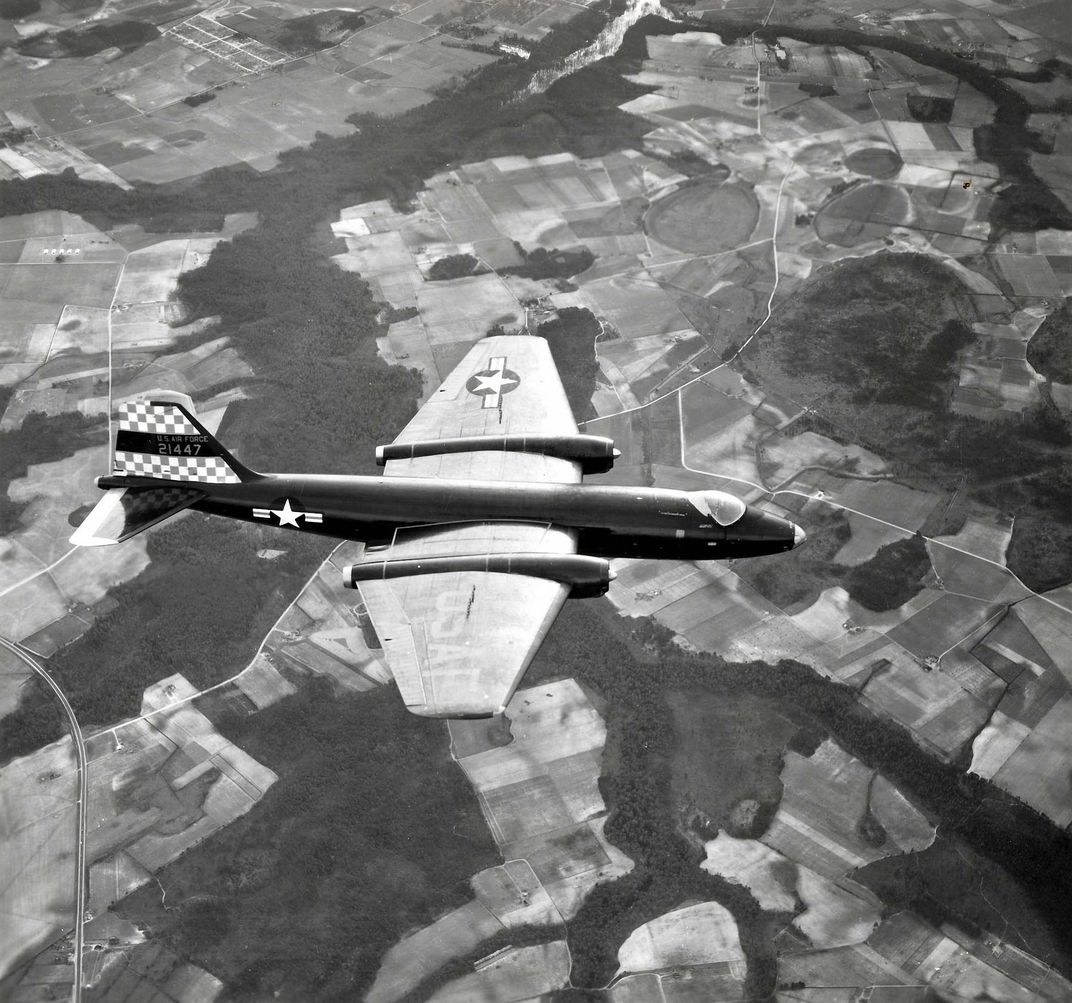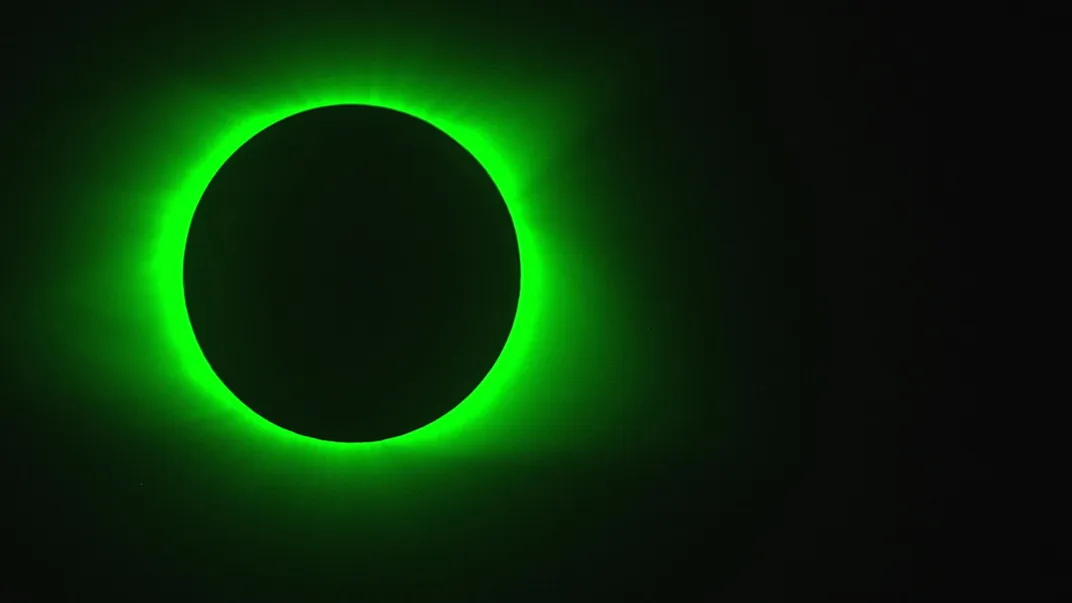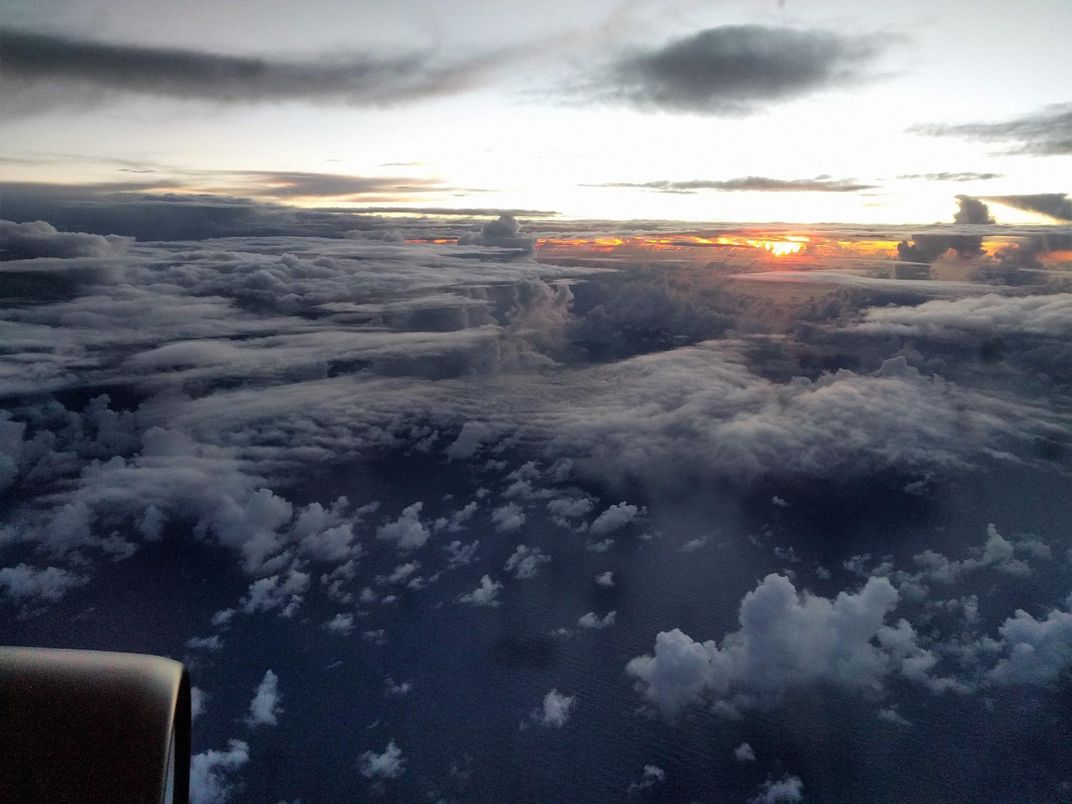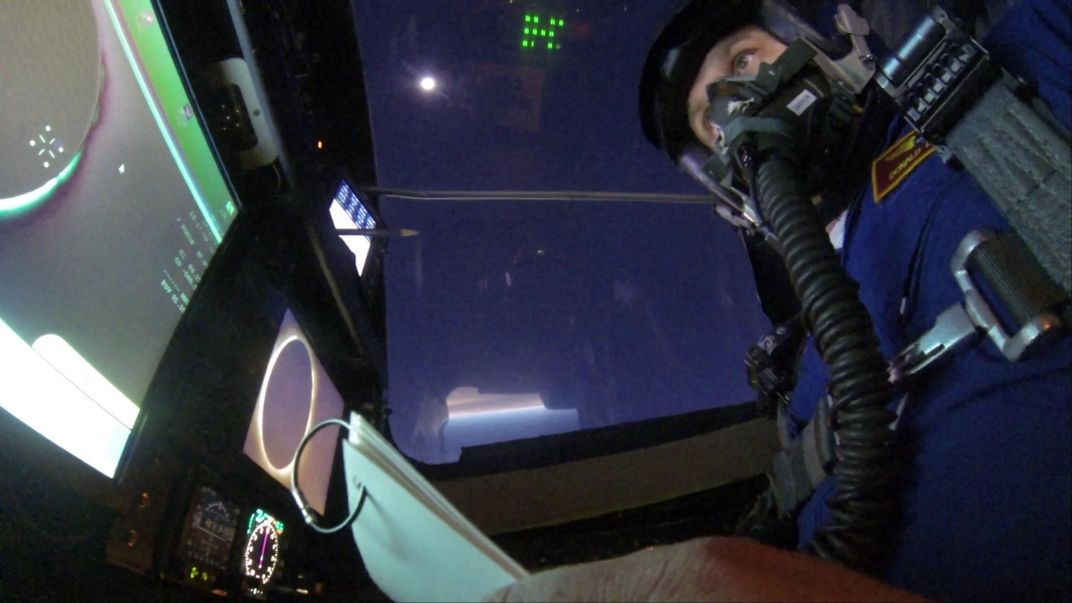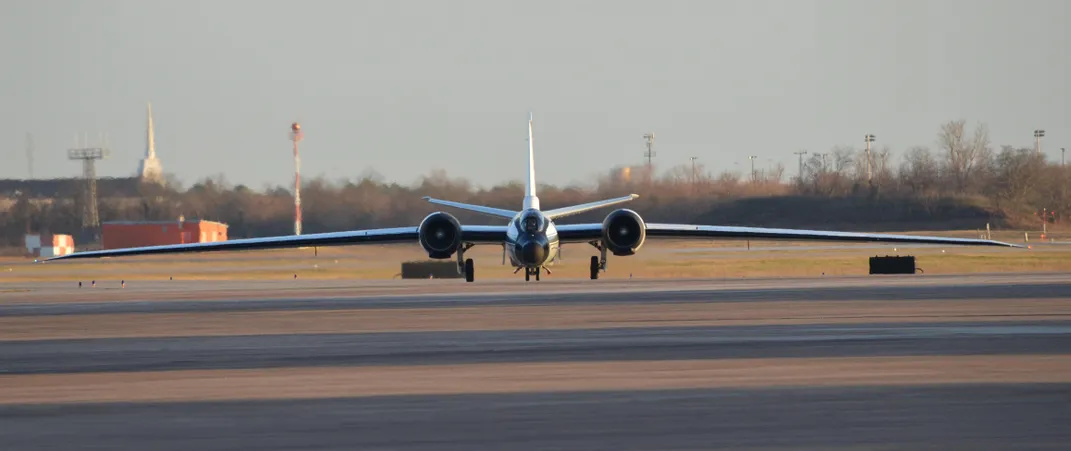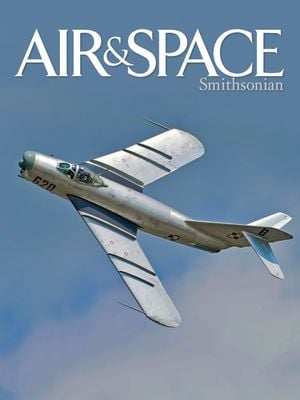A Mission for the Resurrected
To fly through the apex of a storm, NASA needed to raid the boneyard.
:focal(1694x2688:1695x2689)/https://tf-cmsv2-smithsonianmag-media.s3.amazonaws.com/filer/52/94/529433a1-f055-4832-9df9-212dc1795c0d/04f_on2018_formationnasawb-57s11-19-15_live.jpg)
Though it spent 40 years rusting away in the Arizona desert, in October 2016 it was flying miles high over Guam. The Martin WB-57F, with a NASA logo on its tail, climbed into the troposphere on a mission called POSIDON, an investigation of cirrus clouds and other atmospheric phenomena. Porpoising between altitudes of eight and 11 miles, it flew around a typhoon, dipped into volcanic plumes to study sulfur dioxide gas, measured the density and thickness of the clouds, and sniffed for molecules of ozone.
“Cirrus clouds are not so well understood,” says Eric Jensen, an atmospheric scientist with NASA’s Ames Research Center and one of the lead researchers on the POSIDON mission. These structures, which form the anvils on thunderstorms and, at higher altitudes, regulate the amount of water vapor and other particles that float up into the stratosphere, are “one of the big uncertainties in our ability to predict climate change…. So these measurements of the clouds, understanding how they form and how they evolve, is very important to improving these global models,” Jensen says.
The western Pacific is the perfect laboratory for studying cirrus clouds, especially during fall, when thunderstorms are a daily feature and typhoons can spin to life at any time. “Guam is right in the middle of the action,” Jensen says. Warm, moist air rising from the ocean around the island pushes the clouds to especially high altitudes. Strong winds shear off the tops of the clouds, forming the lacy cirrus, which are thin streamers of ice crystals. Tiny particles—from bits of sea foam to factory pollutants blown over from Asia—climb into these streamers, where they can be carried around the entire planet.
The high altitude of these formations makes them difficult to study—too high for most aircraft to reach with heavy instrument payloads and too low and wispy for satellites to view with a high enough resolution for accurate measurements. But in 2011, Jensen’s team got their hands on a WB-57, and the high cirrus came within reach.
The airplane is the last version of the B-57 bomber, with the ability to carry a heavier payload to higher altitudes than any other available research aircraft. “And it’s really hardy, so you can fly near convection—these big thunderstorms—which is a turbulent environment,” Jensen says. With the WB-57s, scientists can send instruments to directly sample the clouds.
The aircraft that flew the Guam mission and two other WB-57s—all three are more than 60 years old—are the only aircraft of their type operating today. The B-57 actually came into the world as the English Electric Canberra, a British-designed jet-powered medium bomber conceived during World War II, though it didn’t make its first flight until 1949. A year later, when hostilities erupted in Korea, the U.S. military began looking for a replacement for the Douglas B-26 Invader (which flew in World War II as the A-26). As part of a demonstration of the Canberra’s suitability, the British bomber made the first unrefueled jet flight across the Atlantic. That cinched the job with the U.S. Air Force. The Glenn L. Martin Company got the license to build the American version, the B-57, which made its first flight in 1953. (Too late for combat in Korea, it was sent there to defend the 1953 armistice.) Though the American version officially dropped the “Canberra” moniker, most still refer to the aircraft by that name.
NASA’s WB-57s fly out of Ellington Airport in Houston, not far from the Johnson Space Center, as part of the agency’s high altitude research fleet. According to Charlie Mallini, who manages the WB-57 program, the airplane occupies a research niche. “It’s one of NASA’s core aircraft for atmospheric work,” he says. “There are only so many aircraft that go to the altitudes we go to. And we can carry a lot of different things—antennas, sample probes, and other payloads.”
NASA’s other high-altitude research aircraft, the ER-2 (a version of the U-2 spyplane) and the Global Hawk drone, fly at least as high as the Canberra and offer greater range and duration. But the Canberra can carry three times the payload of the ER-2 and more than four times that of the Global Hawk. That capacity allows the WB-57 to tote more than two dozen instruments, distributed across the nose, a large payload bay, cubbyholes in the wings, and wing-mounted pods. The Canberra is also the only one of the three research craft that can carry a crewmember in the backseat to operate the instruments and relay data to a team on the ground. “The scientists can make real-time decisions to re-target where they want to go,” says Mallini. “That gives them a lot of flexibility to get the best data.”
Mallini joined the program in 2011 as a lead engineer after working on NASA’s Constellation program, the scrapped initiative to send astronauts back to the moon and on to Mars. In 2014, he became the WB-57 program’s project manager. He shows off the aircraft at their home base, Hangar 990 at Ellington, a former Air Force base. NASA 927, the aircraft that flew the POSIDON mission, sits near the hangar door as Tom Parent, one of the Canberras’ pilots, instructs visiting pilots from the Naval Test Pilot School on its operation. (Small groups of the center’s aviators train on the WB-57F for a few days each year, giving them experience in high-altitude flight.) A second aircraft, NASA 928, is undergoing major maintenance; its engines have been removed and its cargo bay sits open and empty. The final member of the fleet, NASA 926, perches at the other end of the hangar, surrounded by instrument-carrying pallets and shipping containers stuffed full of tools, spare parts, and other gear for deployments outside Houston.
Mallini’s charges look like the aviation equivalent of muscle cars. Their wings span 122.5 feet—almost 20 feet longer than the wings on a U-2S—providing the lift needed to reach altitudes that require pressure suits and giving the WB-57F its nickname: the Long Wing. A hefty Pratt & Whitney TF33 engine, similar to those used in B-52 bombers, is mounted in the middle of each wing and provides the aircraft with 31,000 pounds of thrust. That power makes takeoff both loud (cockpit noise levels can reach 105 decibels) and unnerving. “Quite an eye-opener, and, for a first-time flyer a bit disconcerting,” says Parent. “When the engines are advanced to takeoff power, the entire aircraft shakes so badly it’s difficult to read the engine and flight instruments.”
Parent is one of four pilots for the vintage aircraft. He joined the project in 2011 after retiring from the Air Force. During his 25-year military career, he served as a crew chief for F-111s, then flew B-52s and, finally, the U-2. Nicknamed “Duster” for the thick mustache (a “cookie duster”) that he wore during a deployment to Afghanistan, Parent has logged more than 900 of his almost 8,000 flight hours in the Canberra. In the cockpit, Parent and his fellow pilots face 1960s instrumentation. (The backseat sensors have been updated to modern glass displays.) “Nothing is automated in the cockpit except the new digital autopilot,” says Parent. “The cockpit displays have changed very little since the plane first flew.”
B-57s served for two decades, including in combat in Vietnam. In the early 1960s, General Dynamics was commissioned to design the F model for high-altitude reconnaissance and atmospheric observation. WB-57Fs, operated by the 58th Weather Reconnaissance Squadron in New Mexico, were dispatched around the world to sniff out traces of atmospheric nuclear tests. The last military B-57s were mothballed in 1974, replaced by, among others, the supersonic SR-71.
NASA began borrowing Canberras from the Air Force in the 1960s. After the model had proven its usefulness as a research platform, the agency acquired two permanently. One of them initially served as a reconnaissance aircraft, including a deployment to Rhein-Main Air Base in Germany, while the other began life as a bomber and served Stateside. Both were converted to RB-57F models about 10 years into their careers. “The history is one of the neat things about these aircraft,” says Parent. “Everybody looks at [them] and is amazed that they still exist. Most of them are in museums. In fact, we were looking at museums for our latest aircraft until we found one in the boneyard.”
Air Force 63-13295, also an RB-57F, had retired to Davis-Monthan Air Force Base in Tucson in July 1972. It sat there for almost 39 years, baking under the desert sun. Then in May 2011, NASA engineers descended on the boneyard to resurrect it. “We looked at the work coming up and saw a need for a third plane,” says Mallini. “This was sort of our last opportunity. The planes [at Davis-Monthan] were slowly decaying. And our planes were getting old. It’s like having an insurance policy. And we often have a plane down for maintenance, so the new one allows us to still have two airplanes available.”
It took two years to rejuvenate the aircraft, using parts scavenged from other scrapped airplanes. (A second airframe, which had suffered more damage during its time in storage, served as a testbed, helping engineers determine how to pull things apart and put them back together before applying wrench or screwdriver to 63-13295.) “We stripped it down to bare metal,” Mallini says. “The wings were put up in jigs and rebuilt from scratch. Then we slowly but surely put it back together again.” In August 2013, the redesignated NASA 927 took to the skies for the first time in more than four decades—one of the longest hiatuses for any aircraft consigned to a boneyard.
Keeping three sexagenarian aircraft flying can be time consuming. Spare parts for their older systems can be found only in museums and scrap-yards. The fuselage of the aircraft that served as a testbed for NASA 927’s restoration, for example, was shipped to Utah for testing of an ejection seat upgrade. It then was sent to Houston, where NASA maintenance crew pulled off throttle controls and other levers, wires, and “a number of other odds and ends,” Mallini says. “We’ve scrounged as much as we can scrounge. There are very few aircraft-specific parts to be found.”
To make things worse, original engineering drawings are sometimes incomplete or nonexistent. As a result, the team sometimes has to reverse-engineer components, making them by hand or on 3D printers. Some systems are beyond tweaking and re-creations. That included the 1960s analog autopilot, which used vacuum tubes—items you can’t find at your local Fry’s or even on Amazon. “We had people scouring the Internet for tubes,” says Alyson Hickey, chief engineer for the Canberra program. “We finally replaced the whole thing with a modern digital autopilot.” In addition, the program has replaced the ejection seats with a model used on the F-16, upgraded the landing gear, and installed a new satellite communications system.
The Canberra program helps pay the bill for these extensive modifications and repairs by flying instruments for other government agencies, academia, and the commercial sector. Ten years ago, one of the best customers was the Department of Defense, which booked the aircraft for weeks at a time for its Battlefield Airborne Communications Node program. The Canberra carried equipment that converted it to a “universal translator.” Aircraft and other assets that use incompatible communication systems would use the Canberra to talk to each other. With their NASA logos painted over, the aircraft deployed to Afghanistan beginning in 2008, where they conducted 50 missions. Foreign deployments ended in 2012, when the role was taken over by other aircraft, but the WB-57s still conduct development tests for the program Stateside.
Most of the Canberras’ day-to-day work, however, is conducting airborne science. It’s the ideal aircraft to commission when an unusual task comes along. In August 2017, for example, two WB-57s flying about 50 miles apart observed almost eight minutes of the total solar eclipse along the sun’s path across the United States. More typically, the WB-57s study the air. During the 2015 storm season, one Canberra went on missions over four formations: Hurricane Joaquin and Tropical Storm Erika in the Atlantic and hurricanes Marty and Patricia in the Pacific. It flew at 60,000 feet or higher, tracing figure-4 and other patterns that took it directly over the center of each storm one to three times per flight. “We never had to worry about anyone saying ‘That hurricane is too tall to fly over,’ ” says Daniel J. Cecil, a research scientist at NASA’s Marshall Space Flight Center in Alabama and a principal investigator for one of the storm surveying instruments.
For one experiment, the aircraft dropped into the four storms more than 800 small probes, called dropsondes, each one a little shorter and wider than a paper towel tube. During the 10- to 15-minute descent, they transmitted back to the aircraft wind speed and direction, air temperature and pressure, humidity, and sea-surface temperature, along with GPS-determined altitude. A second experiment used microwaves to measure wind speeds at the ocean surface. “It’s hard to get a direct measurement over the open ocean, especially when the surface is being churned by 100-mile-per-hour winds,” says Cecil. “And instruments on satellites are blinded by the rain, or they’re not able to resolve wind speeds.” Cecil’s instrument measures the increased microwave radiation emitted by the thick seafoam kicked up; the intensity of the radiation indicates the speed of the surface wind creating it.
“Patricia was the most interesting storm,” says Cecil. “Over the course of about a day, it exploded from a tropical storm to the strongest hurricane ever measured in this part of the world. On one pass across the center, we measured the entire eye and eye wall. We got some really good, detailed sampling.”
Perhaps the most ambitious atmospheric mission, though, was POSIDON, the 2016 Guam project. (The mission name is short for Pacific Oxidants, Sulfur, Ice, Dehydration, and cONvection.) It was designed to shed light on physical and chemical processes near the tropopause, the boundary between the bottom layer of the atmosphere, the troposphere, and the next layer up, the stratosphere. “The cirrus clouds that form there serve as the final ‘freeze drying’ of the air on its way to the stratosphere, but the details of the process are complicated,” says Troy Thornberry, a research scientist at the University of Colorado Boulder working with the National Oceanic and Atmospheric Administration, who was the principal investigator for several of the POSIDON instruments. “Historically, climate models have ignored the stratosphere because we thought there was nothing interesting up there,” he says. “As more models became more detailed, though, it has become clear that there are gaps in our knowledge related to the stratosphere that we should address.” This transition area is also where particles like aerosols can be carried into the stratosphere and then circle the globe, scattering sunlight and leading to the destruction of ozone. Thornberry and others are trying to understand the processes at work in the stratosphere now, before human activities modify them further.
To conduct those studies, several dozen scientists, engineers, pilots, and technicians made the 7,500-mile trip from Houston to Guam. The hangars at Andersen Air Force Base were being rebuilt, so the aircraft—boneyard-escapee NASA 927—shared a United Airlines maintenance hangar at Guam International Airport, where the airline crew often invited the science team to join their lunch buffets.
During three weeks on the island, the teams conducted nine science flights. “It was a challenging mission, mainly because of the heat,” says Tom Parent, who piloted several of the flights. “You’d get so hot and so dehydrated that by the time you got airborne you were beat down a bit. Then you’d fly about six hours, and you’d have to conserve gas coming back to an island destination without a lot of divert options, which was a little concerning.”
On many of those missions, the aircraft flew near big convective storm cells, climbing from 43,000 feet to 60,000 feet and back again to collect samples. On two flights, the Canberra studied the outflow from Typhoon Haima, and on its final flight, it dipped into clouds of volcanic gases from islands in Papua New Guinea to sample sulfur compounds. For some of the flights, balloon-launched instruments studied the same patch of sky as NASA 927, providing a check on the data from its payload.
Instrument teams monitored the flights from the United hangar, using weather-satellite images to direct the aircraft to the best locations for sampling. “It was very interactive,” says Eric Jensen. “Our flight paths varied almost constantly to get the most interesting data.” Jensen has been participating in airborne science projects since the mid-1990s, and he calls POSIDON “one of the best campaigns of my career. I can’t say enough good things about the [WB-57 crew]. They were more than willing to take off and land in rainstorms, which the ER-2 is reluctant to do and the Global Hawk won’t even consider. It was just ideal for the job.” Jensen is proposing follow-up missions to study conditions around Japan, off the coast of Africa, and in the Arctic. “That will help us get a full picture of how aerosols are distributed globally,” he says.
But the Canberras have already had long careers, and how much longer they’ll continue to be airworthy isn’t certain. One major engineering challenge in particular looms. All of the large, original machined parts in the wings of NASA 926 and 928 are made of an aluminum alloy called 7079-T6. At the time the aircraft were manufactured, “it was the material—it was great stuff,” says senior WB-57 engineer Kevin Krolczyk. “Years later, though, they found out that it has poor stress corrosion properties—it’s highly prone to stress-corrosion cracking.” Any tension, including the “drooping” of the wings when the aircraft are on the ground, exacerbates the problem. “Nobody uses it now. But we can’t [remove it from the aircraft] because the whole [wing] structure is made of that material,” Krolczyk says. Maintenance crews routinely inspect the wings, and the team has replaced a few smaller pieces of spar—about 10 to 15 percent in all. (Since the team had to largely rebuild NASA 927 anyway, they took the opportunity to outfit it with new wings.) “We inspect a lot and have good repair procedures, but eventually that won’t be enough,” Krolczyk says. “The question is, is that two years away or 20? It’s really hard to say.”
Even so, Charlie Mallini says there’s no reason to fret, adding that the science they provide is well worth the trouble to keep these aircraft long past the day the rest of their line was put to pasture. “We’re going to keep going,” he says. “There are no plans to retire these airplanes”…again, that is. Arizona will have to wait a while for NASA 927 to settle back in the boneyard. It’s got a hurricane to fly through.
